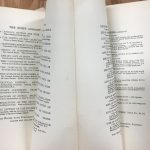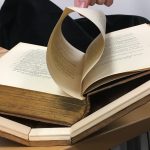While scanning the different copies of The Wide, Wide World, I found some quirky details inside the 1896 Walter Scott edition. I found a bookmark, without a date, advertising an old “life assurance” company. The front of the bookmark lists the benefits of “The Methodist and General Assurance Society Ltd.” The back of this elaborate bookmark pictures a house in the country surrounded by flowers. Another oddity in this novel is the uncut pages at the end containing the advertisements. When this book was published, not all books came ready to read, as some publishers printed a few book pages on one large sheet of folded paper, and did not cut these separate pages apart. Readers would use a tool to cut pages, much like people cut open envelopes today. Though the majority of this particular edition has its pages free to read, the last eight pages of advertisements are not precut. The reader of this particular book did not care to read the advertisements apparently. Dr. DeSpain will use a letter opener in order to tear them apart. As it stands, the four middle pages are not legible because they are hidden between other pages of advertisements. I had never seen pages left uncut, as publishers now do not print the same way as this particular book was printed. It makes book history more unique and fascinating when a book demonstrates a past technology that I had never seen/heard of before working on this project. This project has taught me so much about the various parts of books and how books were once made.




